15 Content Marketing Metrics to Track for Success

Content has become an efficient tool for engaging and retaining the audience's attention. Metrics, however, play a key role in determining the performance of marketing strategies.
Metrics allow a business to understand how content interacts with audiences, providing the necessary data to adjust strategy. It's not just numbers and indicators; it's a tool that allows you to see what's working and what needs improvement or change.
In this brief, we will discover the primary metrics for assessing content quality. From SEO (search engine optimization) metrics that gauge your website's visibility to audience analysis metrics that measure engagement and conversions. Our experts unveil the secrets to discovering the true power of your content. Analyzing the results will help you make your marketing strategy even more targeted and effective and lead you to success. Let's begin our research!
Content marketing and its core metrics
Content marketing is a strategic approach adopted by organizations to disseminate valuable information to attract and retain a specific customer demographic. Rather than solely emphasizing the brand, product, or service, content marketing prioritizes the audience by crafting informative content tailored to their needs and interests.
Here are several advantages of utilizing a quality content marketing strategy:
Enhances search engine visibility: Each new piece of content added to your website or blog expands your indexed pages, potentially boosting your search engine ranking and visibility.
Boosts brand awareness: Consistently providing valuable information helps your brand stay top-of-mind for customers, ultimately increasing brand recognition and awareness.
Attracts new customers: Effective content marketing can build an audience interested in your offerings, drawing in new customers seeking valuable information about your products or services.
Drives revenue growth: Content marketing can foster customer loyalty, leading to increased revenue through cross-selling and up-selling opportunities.
Improves conversion rates: By providing valuable, engaging content, you will steer potential customers through the sales funnel, raising the prospect of conversions.
Expands social media following: Sharing high-quality content on social media platforms can attract more followers and improve interaction with your audience.
Generates quality leads: Consistently delivering valuable content builds trust with customers, increasing the chances of converting them into leads and eventual customers.
Establishes brand authority: Regularly sharing informative content positions your brand as an industry authority, earning customer trust and boosting your reputation online. This credibility can also elevate your rankings in search engines.
Based on the most recent projections, the content market sector is expected to surge to USD $107 billion by 2026. This expansion underscores the pivotal role that content marketing plays in modern business strategies, emphasizing the need for a nuanced understanding of key metrics to drive impactful outcomes. So, what are the content marketing success metrics, and why are they essential?
These metrics serve as vital data points crucial for assessing and enhancing your agency's content strategy effectiveness. They offer insights into various aspects, such as the performance of social media posts, traffic generation, and their impact on the sales funnel.
Depending on the content type, multiple key metrics can be tracked:
Assess the performance of current content.
Determine the most resonant content types with the target audience.
Evaluate the alignment of content marketing efforts with overarching business objectives.
By considering these metrics, you can improve your content marketing strategy to increase performance and justify marketing expenditures more effectively.
Here are some popular tools for measuring metrics for content marketing strategy:
Google Analytics: It is a complex web analytics tool that presents insights into user behavior, web traffic, and conversion metrics. This solution helps businesses understand audience demographics, content performance, and more.
HubSpot Marketing Analytics and Dashboard Software: An integrated marketing platform offering robust analytics capabilities and a content marketing metrics dashboard to track performance across various channels. You can discover website traffic, social media engagement, email marketing, and lead generation efforts.
Buffer: A social media management solution that offers analytics features to track engagement metrics, target group demographics, and content effectiveness across multiple social media networks. This tool enables businesses to improve their social media strategy.
Semrush: An all-in-one search engine marketing (SEM) toolkit that includes analytics features for pay-per-click (PPC), technical SEO, social media, and content marketing. Semrush provides insights into backlink profiles, keyword rankings, analysis of the competitors, and content performance.
Databox: It is a business analytics platform that integrates data from various sources, including Google Analytics, HubSpot, and social media platforms, into a customizable content marketing metrics dashboard. It enables users to track KPIs (key performance indicators) and check metrics in real-time.
Ahrefs: This SEO toolset includes analytics features for backlink analysis, keyword, and competitor research. It provides information on content performance, search visibility, and organic traffic metrics.
Supermetrics: A data integration platform that connects various marketing data sources, such as Google Analytics, Facebook Ads, and Semrush, to reporting tools like Google Sheets and Data Studio. It enables enterprises to make custom reports and analyze metrics across multiple channels.
SimilarWeb: This competitive intelligence tool gives an idea of website traffic, audience demographics, and online behavior. It helps businesses benchmark their performance against competitors and identify growth opportunities.
Hotjar: A website optimization tool that offers analytics features such as session recordings, heatmaps, and surveys to understand user behavior and collect feedback. Hotjar helps businesses optimize their website content and user experience based on actual data.
Choosing the right tools to measure metrics for content marketing depends on your unique goals, target audience, and the type of content. However, using a combination of different tools allows you to get a complete picture of how users interact with content, helping to optimize the strategy in accordance with the real needs of the audience.
Top metrics for assessing visibility
The absence of organic search traffic significantly reduces the likelihood of your content achieving the desired number of leads or conversions sought by you or your clients. This segment will delve into five on-page SEO metrics showing content performance in search engine results.
1. Organic search traffic
Unpaid search engine results drive organic search traffic, representing visits to a website without paid promotion. Monitoring this metric helps to understand the effectiveness of content in attracting the intended audience.
Tools such as Google Search Console facilitate tracking organic search traffic. Navigate to "Performance" in the sidebar, then select "Search results" to view clicks to your site from search engine results pages (SERPs) over the past three months. This data reveals trends in visitor attraction to your content.
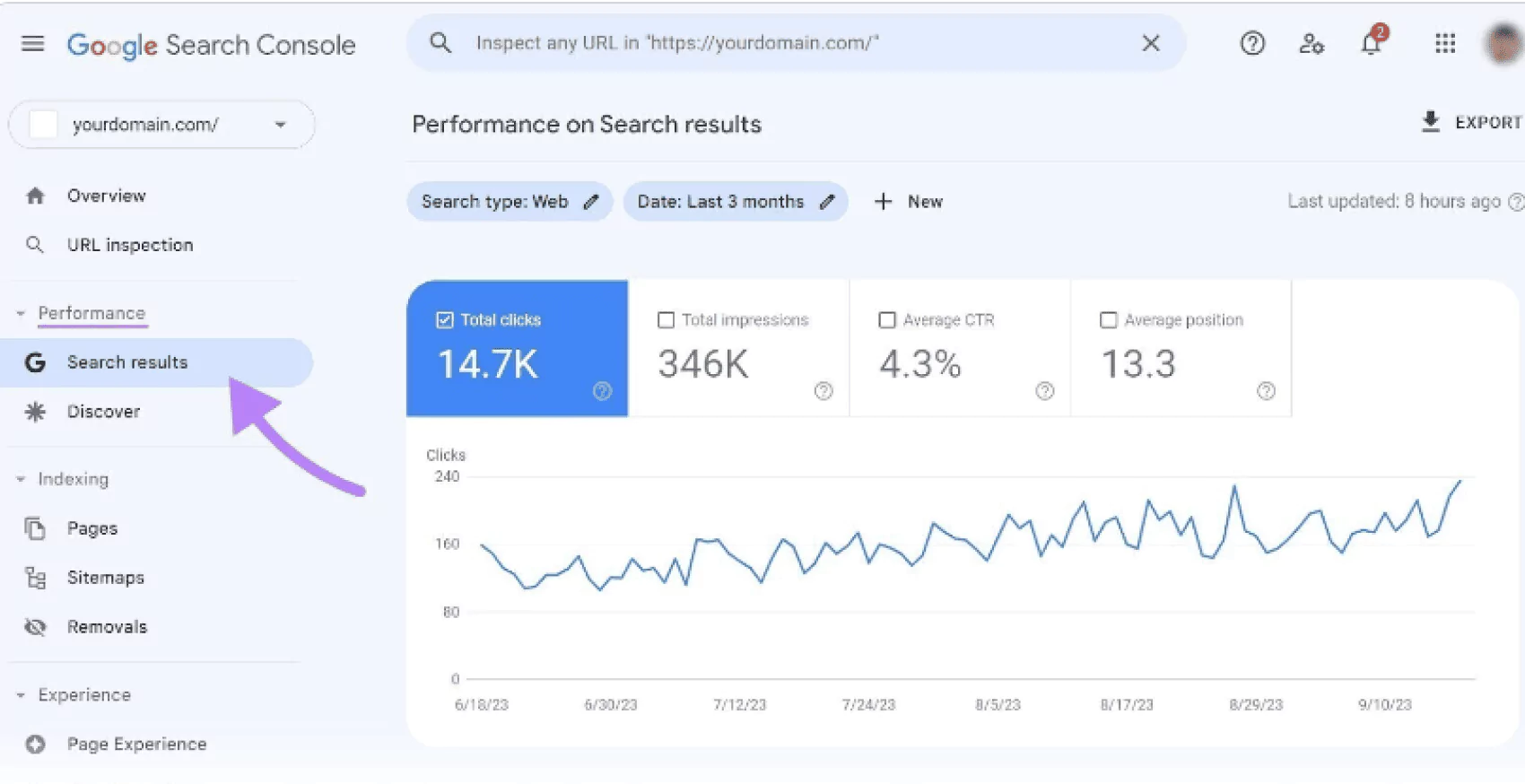
According to research conducted by Total Retail, 88% of B2B (business-to-business) websites and 58% of consumer retail sites are discovered through unbranded search terms. Despite this significant trend, the majority of company websites prioritize ranking and paid search strategies for branded terms.
Understanding organic search traffic is essential for optimizing your B2B content marketing metrics. This means improving the website's visibility and attracting qualified visitors proactively searching for information connected to your content.
2. Views
Pageviews are among the primary metrics in content marketing, indicating the total times a page loads. This metric registers each instance page that loads in a browser, irrespective of repeat views by the same visitor.
While pageviews offer a basic assessment of article or webpage performance, they should be complemented with other content marketing metrics that matter for a comprehensive understanding of the strategy’s work.
To track views, you can use Google Analytics 4, the latest version. Find the “Reports” section on the left-hand menu. Then, pick “Engagement” and tap on “Pages and Screens” from the drop-down menu. Scroll down and check the total number of views to diverse web pages in frames of a certain time period.
You can tailor this report according to the specific type of content you wish to monitor, the duration, and other relevant factors.
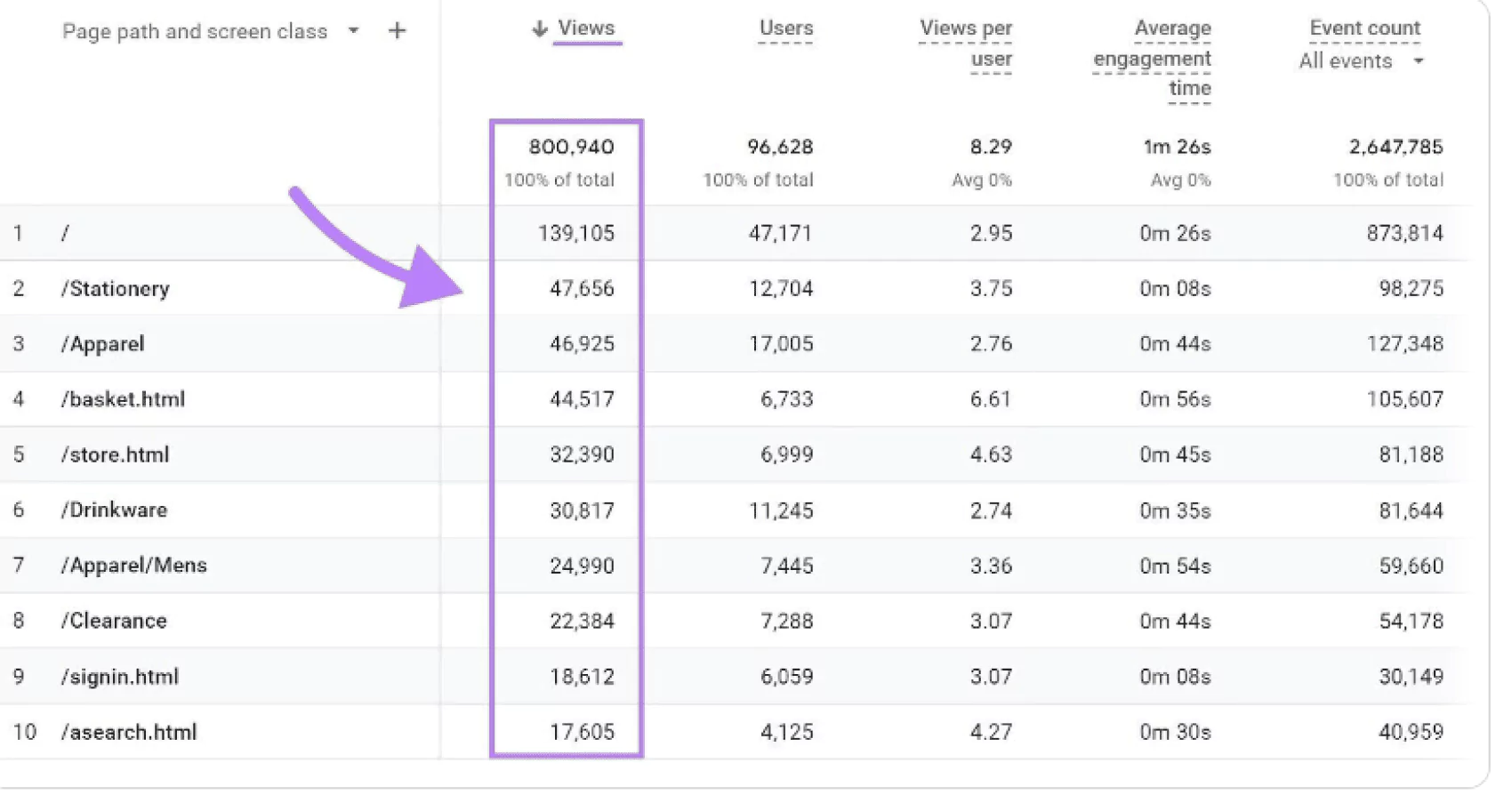
3. Keyword rankings
If you're utilizing SEO as a distribution channel, monitoring keyword rankings provides valuable insights into the effectiveness of your marketing endeavors. Before a blog post can attract traffic, it must rank prominently in search results. Thus, keyword rankings serve as a crucial indicator of progress.
A robust website with optimal performance, site speed, and backlinks is essential. Additionally, targeting appropriately challenging keywords and producing high-quality content aligned with search intent is vital.
Remember, a quality website should witness a gradual increase in keyword volume after a while. To monitor keyword rankings, utilize tools like Google Search Console or various SEO platforms such as Ahrefs, Semrush, or GrowthBar.
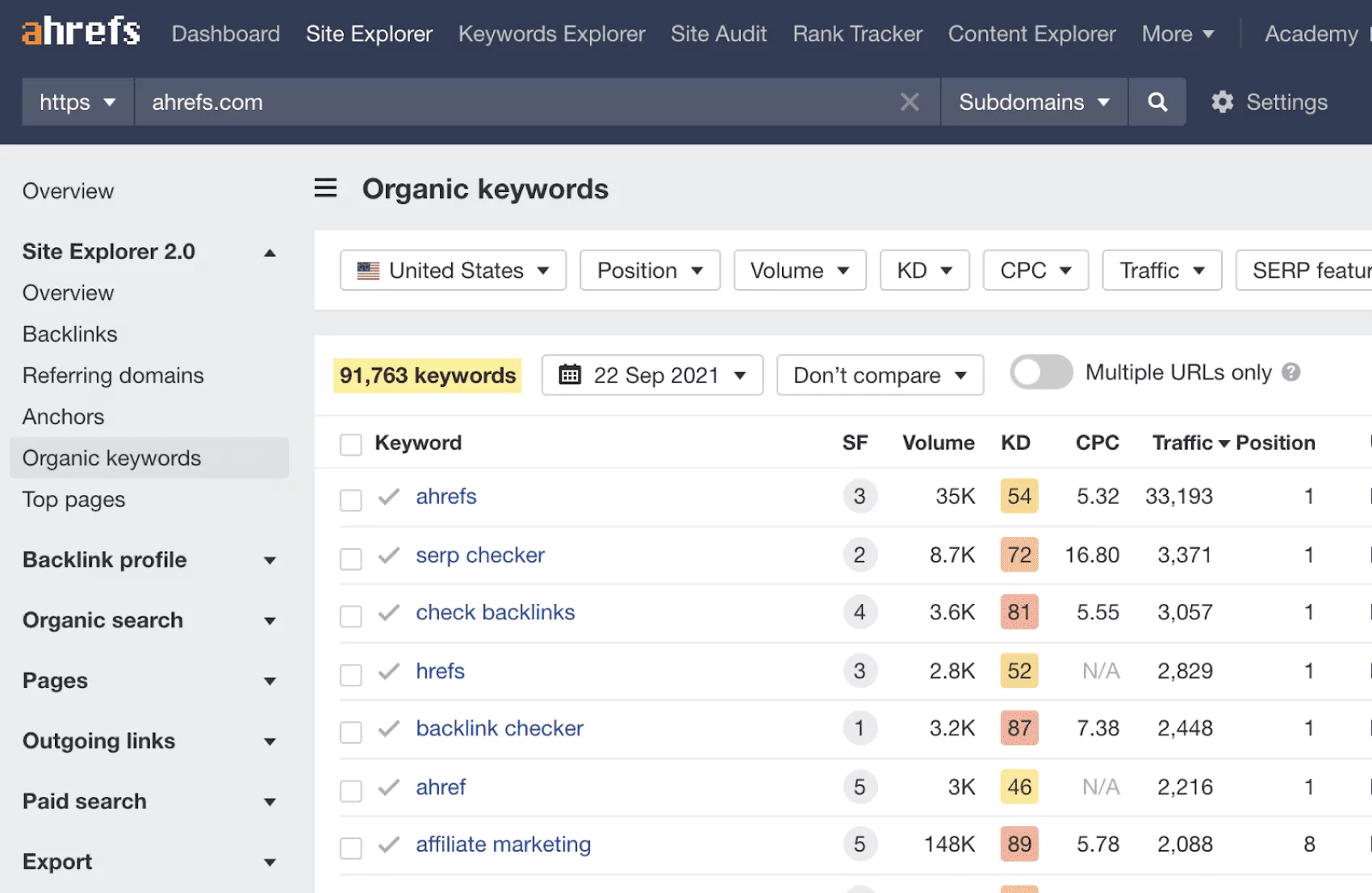
In general, tracking keyword rankings allows you to gauge your website's visibility and make informed decisions to enhance your SEO content efforts.
4. Backlinks
In addition to keywords, backlinks serve as another metric for content performance evaluation. They gauge the impact of content on a site's authority.
Backlinks remain crucial because they significantly influence rankings. Pages with more backlinks have higher chances of ranking well. Additionally, the acquired link equity enhances the authority of the entire site through internal linking.
In the initial stages of site development, tracking backlinks may not yield significant insights as earning them naturally or through link building takes time.
For example, using Ahrefs, you can turn on the Best Links mode to check the growth of the most effective backlinks.
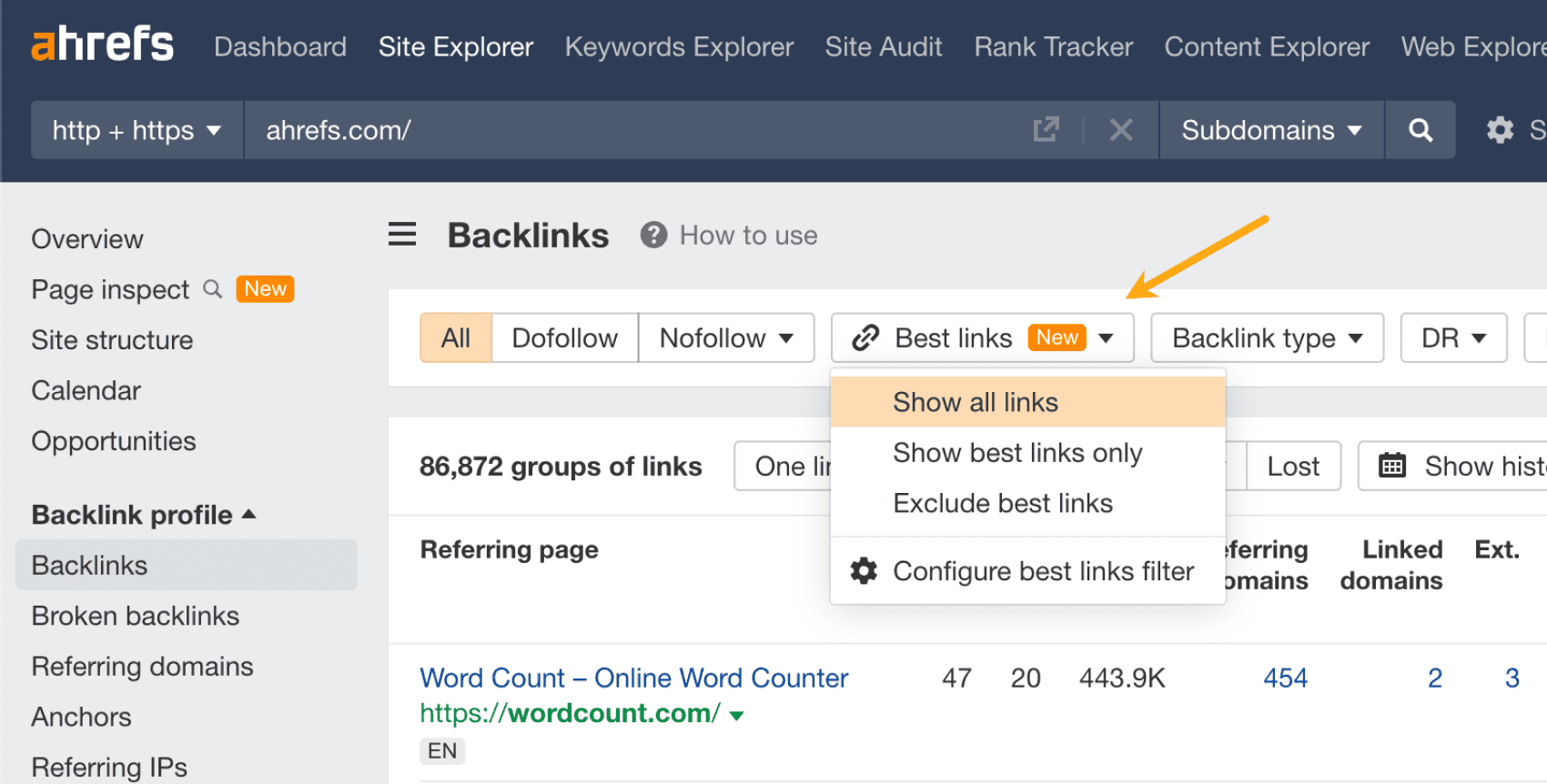
5. Impressions
This metric denotes the overall count of times content, such as an advertisement or a social media post, is exhibited or presented to users on a specific platform. For instance, if a LinkedIn post appears 500 times in users' feeds, it has garnered 500 impressions.
Monitoring impressions helps gauge the extent of exposure your content receives. To track impressions accurately, it's advisable to utilize the analytics tools provided by each platform individually.
For instance, you can use LinkedIn's analytics feature to track impressions on the platform. To do so, navigate to your company's profile and ensure you have administrative privileges.
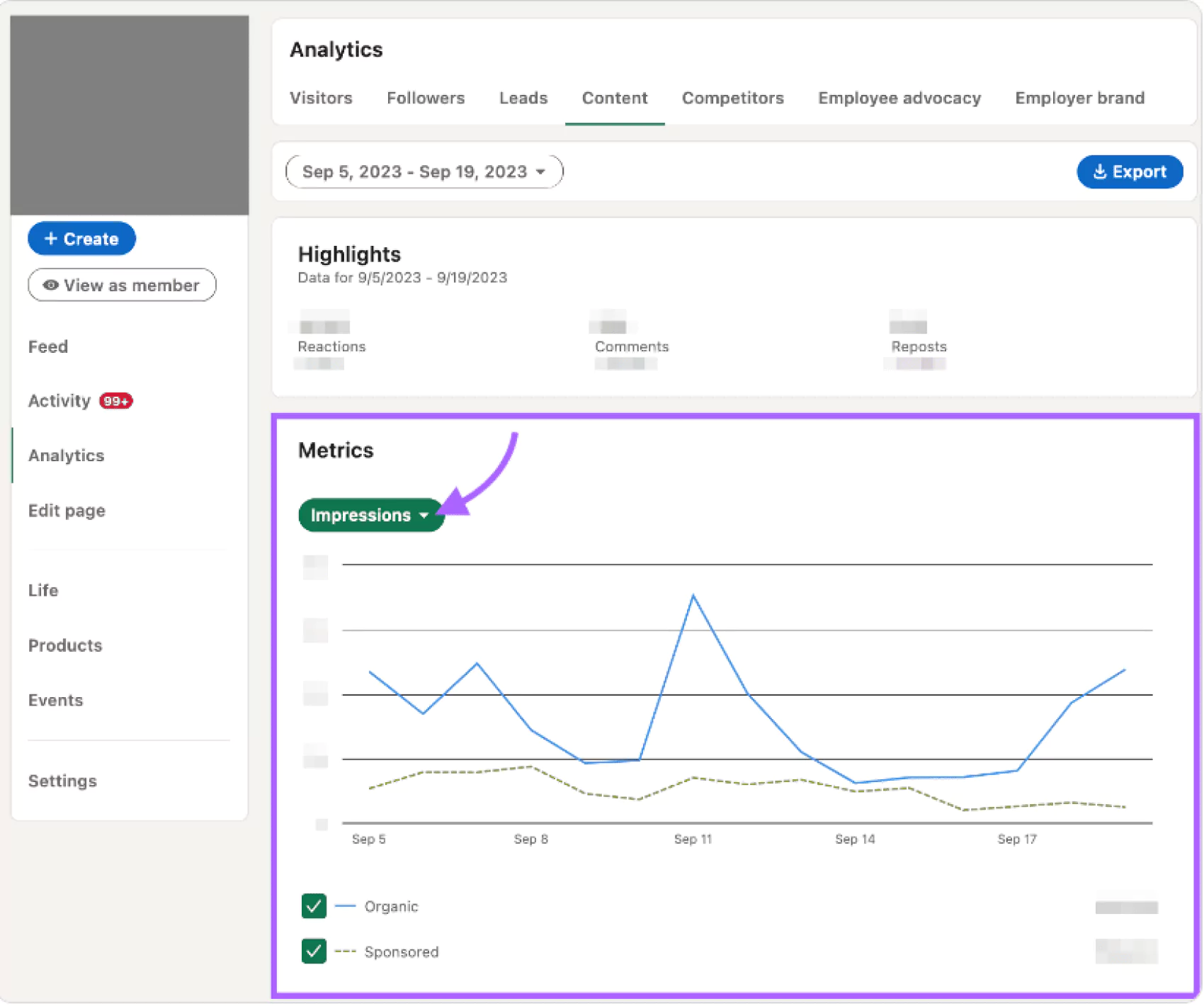
Discover also: The Power of SEM Tools for Digital Marketing
Key metrics for monitoring conversions and revenue
So, you've crafted compelling content, attracted a captivated audience, and driven them to your website. But the journey doesn't end there. The main goal is to convert that attention into action, whether it's a sign-up, a purchase, or another wanted outcome. Here's where the power of conversion and revenue metrics comes into play.
1. Conversion rate
The conversion rate is one of the top content marketing metrics to track. It signifies the proportion of individuals who have undertaken a desired action within a designated timeframe. These actions mean subscribing to an email newsletter, contacting your business, or scheduling a demonstration.
For instance, if 5,000 individuals visit your landing page in a month and 300 of them schedule a demo, your conversion rate stands at 6%. Below, you can see a formula for how to calculate a customer conversion rate.

Monitoring conversion rates offers valuable insights into the extent to which your content aligns with your objectives.
To monitor conversion rates for particular pages, you can establish conversion events in Google Analytics tailored to your conversion objectives. This can be implemented for any pages you wish to analyze individually.
Discover also: Google Search Console vs Google Analytics: A Full Analysis
2. Content marketing ROI
Content marketing return on investment (ROI) represents the percentage indicating the revenue acquired from content marketing in comparison to the expenditure incurred during a particular timeframe.
For example, if you earned $2,000 from your organic social content after investing a total of $500, your ROI stands at 300%.
To compute your content marketing ROI, utilize the following formula:
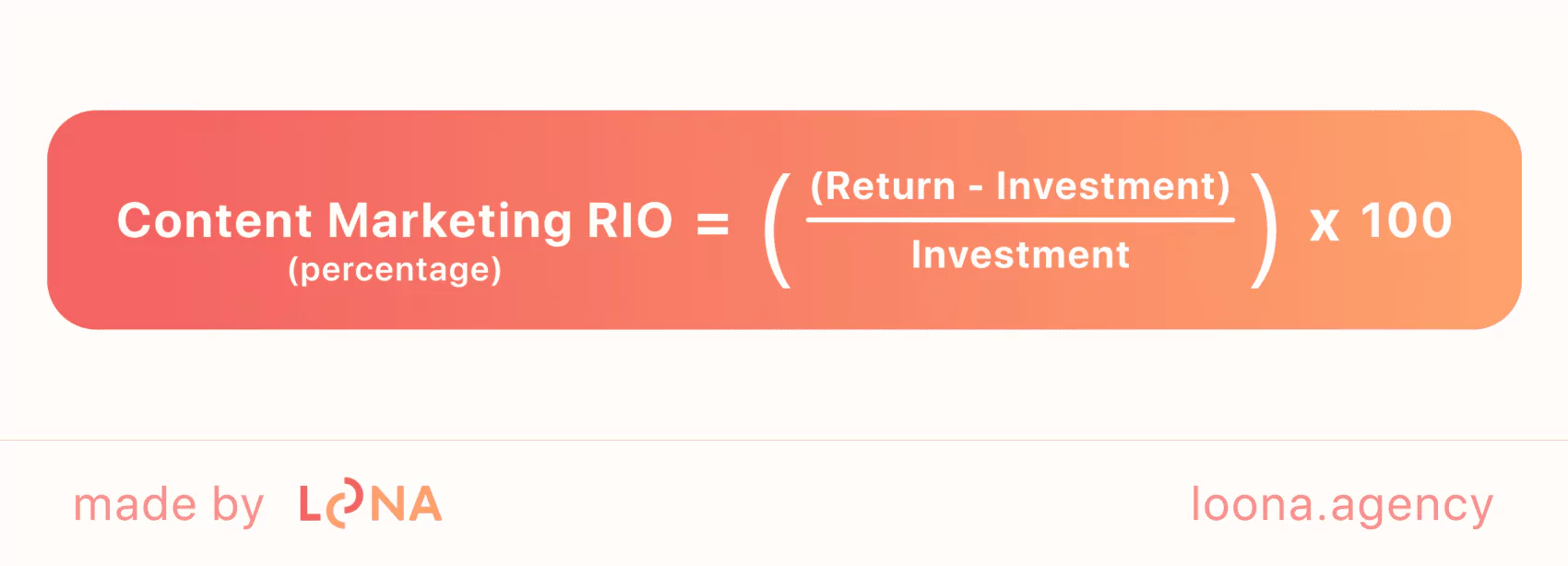
In addition to its role in fostering trust and expanding brand recognition, social media serves as a potent catalyst for amplifying your content. Therefore, it is crucial to assess content marketing ROI across platforms such as Twitter, Facebook, Instagram, and others.
Take into account the diverse range of audiences you cater to and the specific goals and objectives associated with each. Particularly in B2B content marketing metrics, social media serves as a platform for fostering valuable partnerships, constituting a tangible asset to your marketing endeavors.
Critical metrics for identifying audience traffic sources
This section will equip you with the critical metrics for content marketing that lead you to a deeper understanding of your audience's traffic sources. By considering this information, you can craft content that is seen as made specifically for your users, no matter where they find you.
1. Traffic sources
It's great to see people engaging with your content, but understanding how they discovered it is equally crucial. A successful content marketing strategy not only draws in new prospects with compelling content but also fosters engagement with existing or potential customers. This involvement can maintain brand visibility and lead to repeat business.
Regardless, knowing the sources of your content traffic is essential. Content marketing metrics in Google Analytics can assist you in identifying traffic sources for your blog or website. Below, you can see how to find this metric in GA4.
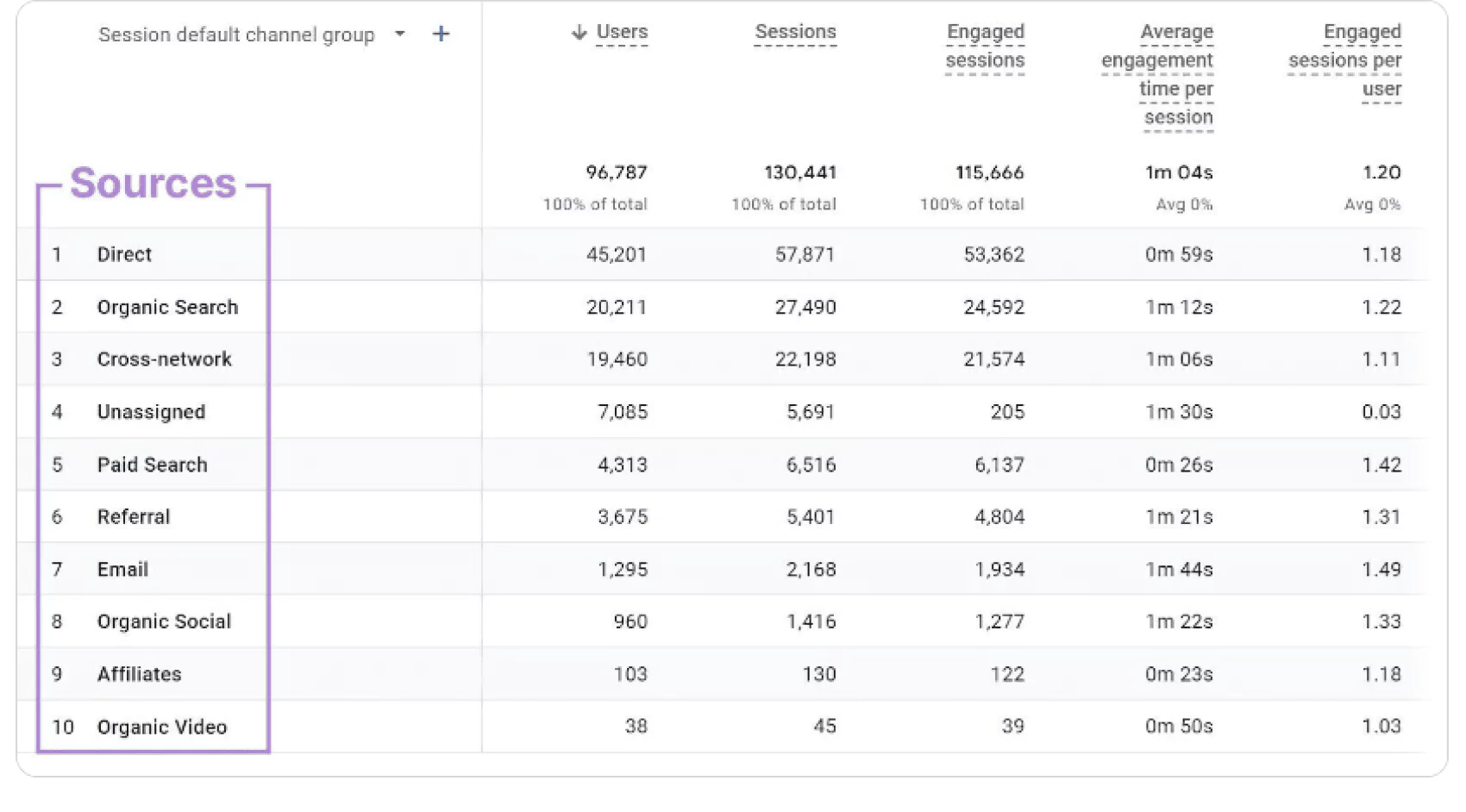
By taking into account traffic sources, you can find which channels drive the most visitors to your webpage, whether through social media, organic search, referral links, or direct traffic. This information allows you to distribute resources effectively, concentrating on channels with the highest engagement and conversion rates.
Moreover, recognizing the diversity of traffic sources enables you to expand your marketing efforts and cover a broader audience. For example, if you discover a large part of your traffic comes from social media platforms, you can put more resources into crafting engaging social media posts or running targeted advertising campaigns.
2. Brand mentions
It may seem obvious, but when your brand is being discussed online, it's a clear sign of awareness. Understanding what customers are expressing about your brand and offerings holds significant value. Monitoring online brand mentions yields genuine feedback and impartial insights from existing and prospective customers.
Various tools are available to facilitate tracking brand mentions online. For instance, Google Alerts enables the creation of custom alerts for brand mentions across the web. Additionally, platforms like Hootsuite offer capabilities to monitor brand mentions, keywords, and phrases across multiple social media channels.
Below, you can see how Nike was mentioned on LinkedIn as a subject of discussion.

Being mentioned by others not only expands your reach but also holds the potential to shape their perception of your brand positively. When individuals or entities acknowledge your presence or endorse your offerings, it amplifies your visibility, allowing you to connect with a broader audience. Furthermore, such mentions often carry implicit endorsements. This drives a sense of credibility and trustworthiness among those who encounter them.
Primary metrics for evaluating user engagement
Customer engagement is the life force of content marketing. It ignites a connection between you and your target group, turning passive viewers into active contributors. But how do you discover the depth of engagement?
This section dives into the primary content marketing metrics beyond surface-level interactions. We'll consider the key indicators that reveal how thoroughly your target audience connects with your content. This will allow you to identify what truly resonates and optimize your strategy for maximum user engagement.
1. Growth of followers
Subscriber/follower growth is a crucial content marketing metric that reflects the percentage of newly acquired social media followers or subscribers within a defined timeframe.
A robust growth rate in followers or subscribers signifies that your social content is resonating with a wider audience, effectively expanding your reach and influence. By monitoring the steady increase in your social media followers or subscribers over time, you can gauge the effectiveness of your content strategy in engaging and attracting new audiences.
Apply the analytics tools each social media platform provides to check and analyze the growth in your follower or subscriber base. These data enable you to assess the impact of your content efforts and take informed actions to enhance your social media presence for continued growth and engagement.
Below is a diagram that shows the growth of followers on LinkedIn during the past 90 days. On this social platform, you can customize the time period to obtain a precise report on your new subscribers and compare data.
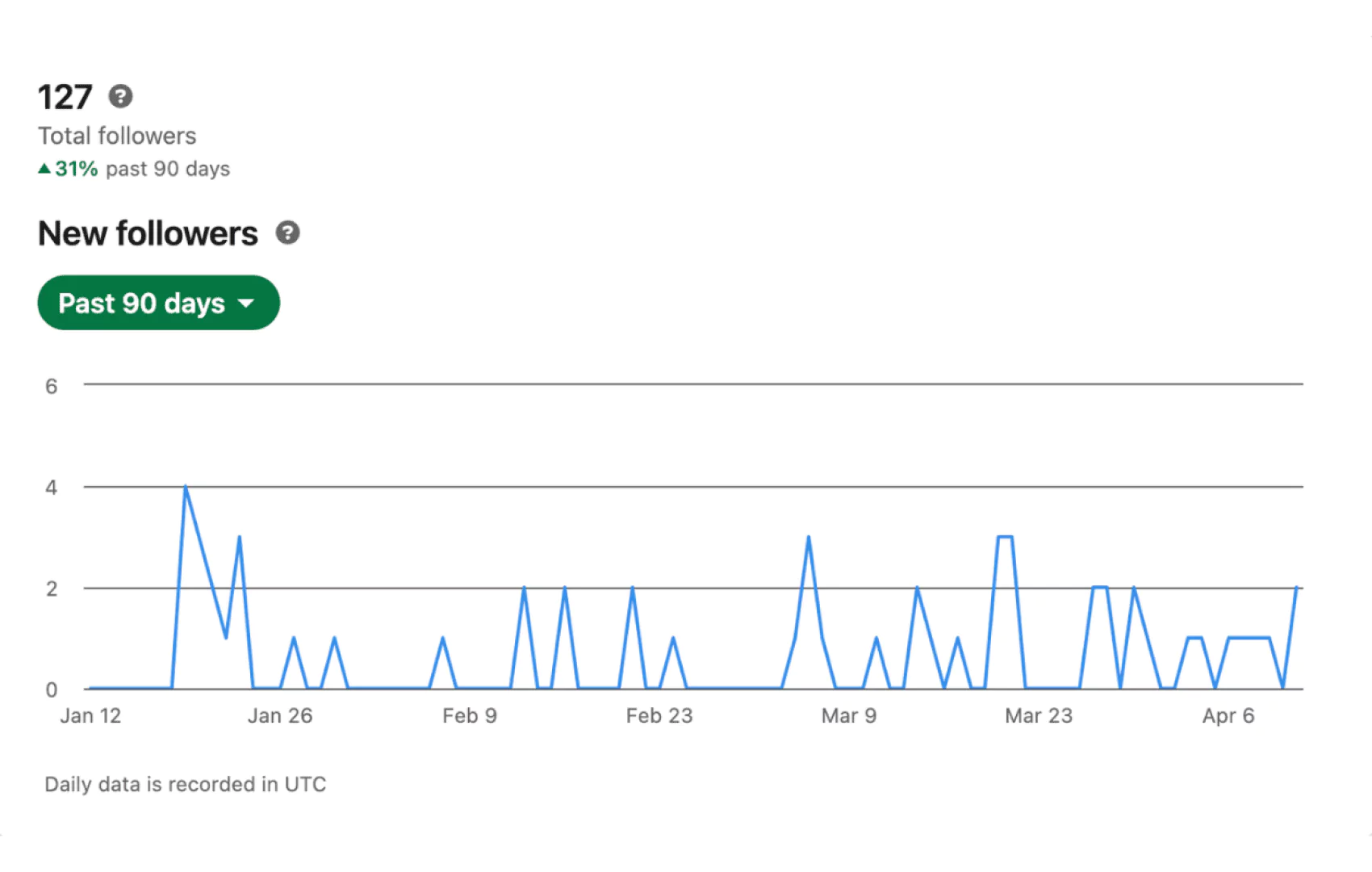
Furthermore, you have the ability to monitor the growth rates of your competitors' followers over designated time frames, be it monthly, quarterly, annually, or any other chosen period.
2. Average engagement time
User engagement measures the duration individuals spend actively interacting with your website or app interface. It presents valuable information on how effectively your content captivates and retains users' attention.
By tracking user engagement metrics such as average session duration and screen time, you better understand the quality of your content and user experience (UX). Longer engagement times typically show that people find your content engaging and helpful. This potentially leads to increased conversions and brand loyalty.
Several factors may contribute to a low average time on page:
Inadequate legibility,
Limited scannability,
Excessive text length,
Subpar user experience,
Low-quality content,
Uninteresting topics.
Utilizing tools like Google Analytics 4 enables you to monitor average engagement times for individual web pages. So, you can identify which content your audience likes the most. This data empowers you to make informed decisions regarding content optimization and user experience enhancements to drive higher engagement and overall performance.
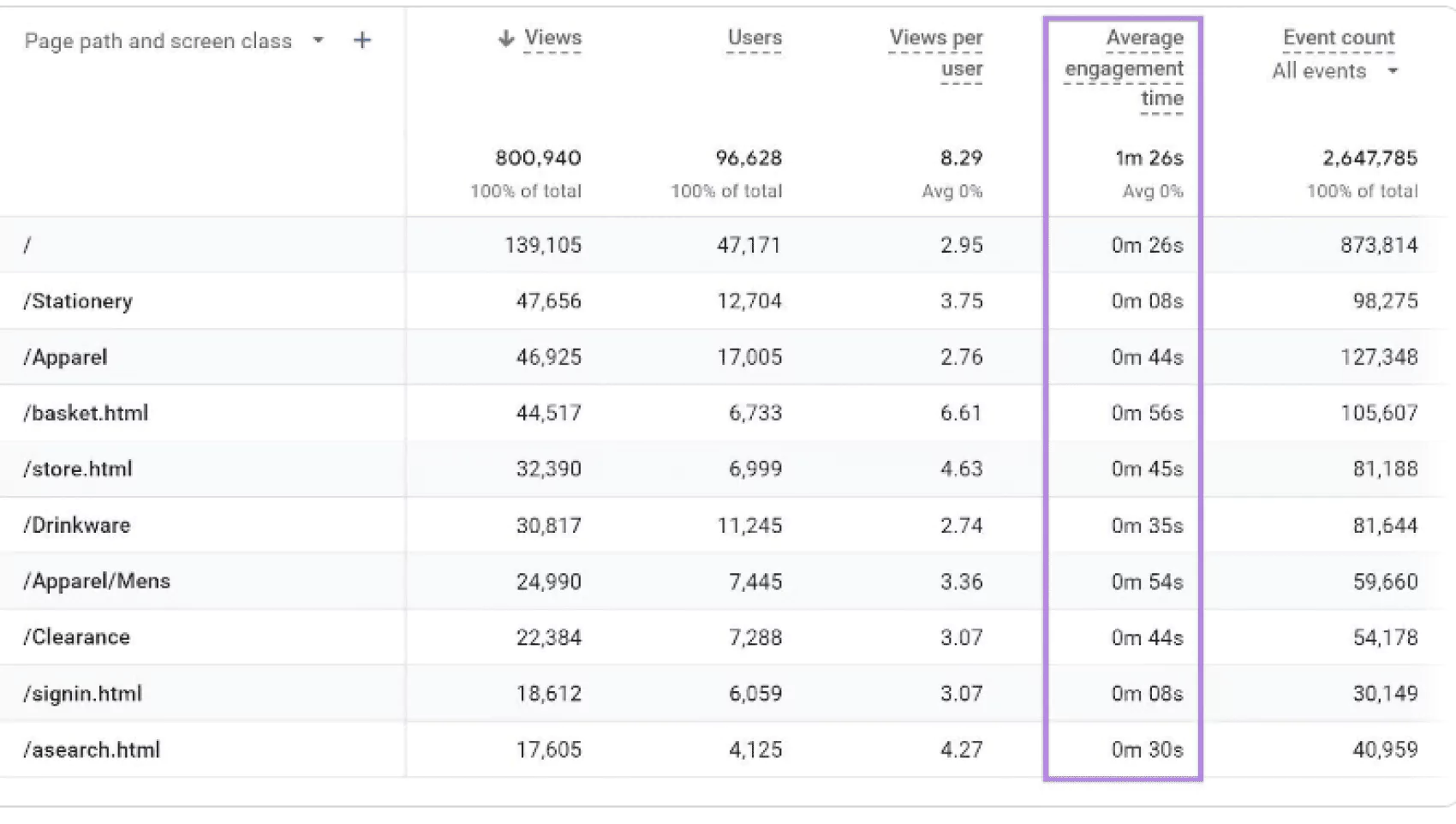
3. Average engagement rate
The average engagement rate on social media measures the proportion of individuals interacting with your social content in relation to your total number of followers. Conversely, on your website, it signifies the percentage of engaged sessions, as defined by Google Analytics.
Engaged sessions encompass various user behaviors, including remaining on your website for more than 10 seconds, completing conversion events like booking a demo or contacting your business, or navigating through multiple pages or screens. Analyzing your average engagement rate across different channels provides helpful data into the performance of your content and user engagement strategies.
To assess this metric in Google Analytics 4, navigate to the “Traffic acquisition” report within the “Acquisition” section. A significantly low average engagement rate may indicate that users perceive your content as irrelevant or uninteresting, or it could suggest underlying issues with your website’s user experience, such as slow loading times or broken links. Evaluating and addressing these factors can help improve user engagement and the overall performance of your website.
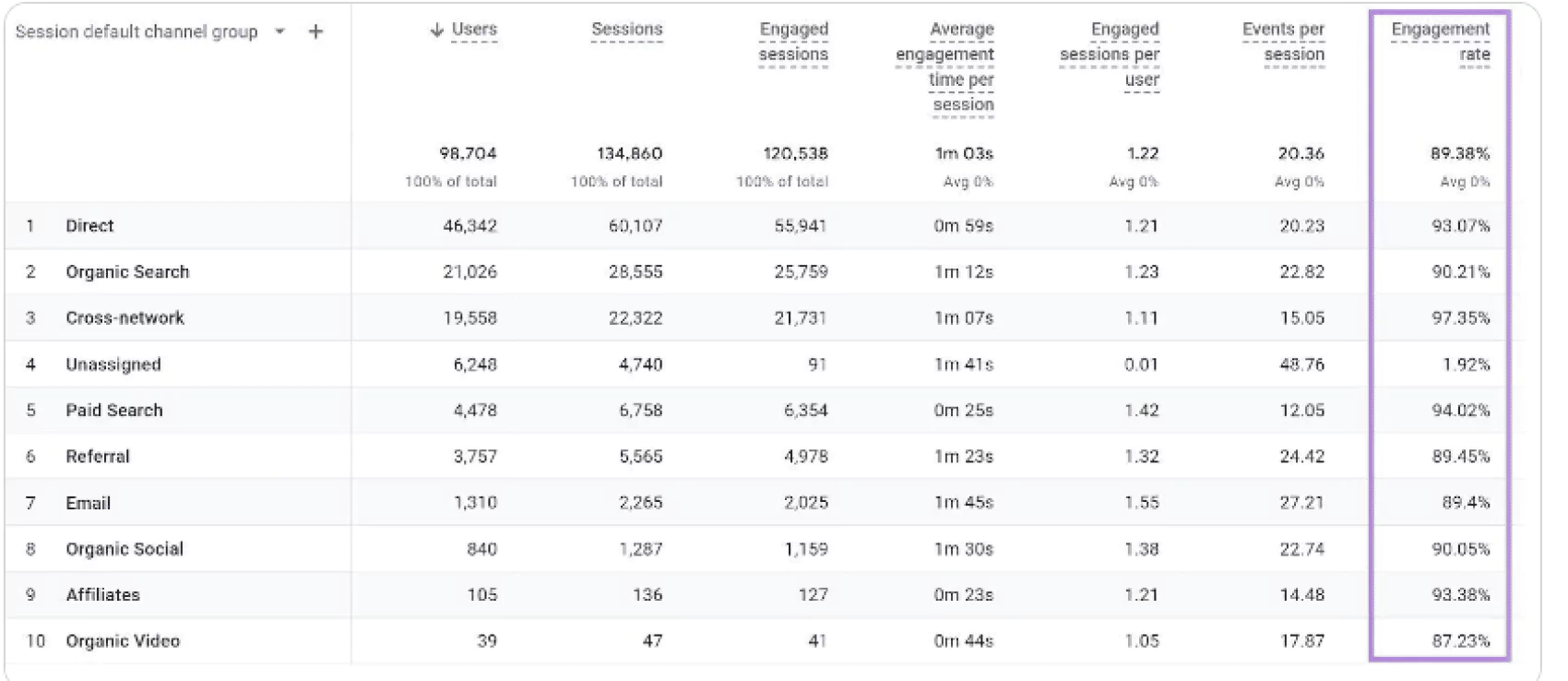
4. Click-through rate
Measuring impressions or views of your content is crucial, but without considering your CTR or click-through rate, you lack a comprehensive understanding of its effectiveness. While many may see your content, it's essential to know if it's prompting action - leading viewers to your website or engaging with your products. Evaluating your click-through rate helps to measure audience engagement and conversion potential.
Click-through rates can take diverse forms and directions based on the stage of the customer journey within your digital marketing funnel. Here are several instances:
User register for your product or service,
People acquire a software application or resource,
They navigate to a demo request form,
Users subscribe to your newsletter,
They register for an event,
They participate in your community.
A strong CTR suggests that a part of content captures the user's interest when it appears on the search engine results page. Several factors can cultivate this engagement, including:
Compelling headlines,
Titles rich in relevant keywords,
Effective meta descriptions,
Adding excerpts.
You can monitor CTRs using various platforms aligned with your diverse marketing initiatives. This includes utilizing an email marketing platform, a social media management tool, and a Google Search Console.
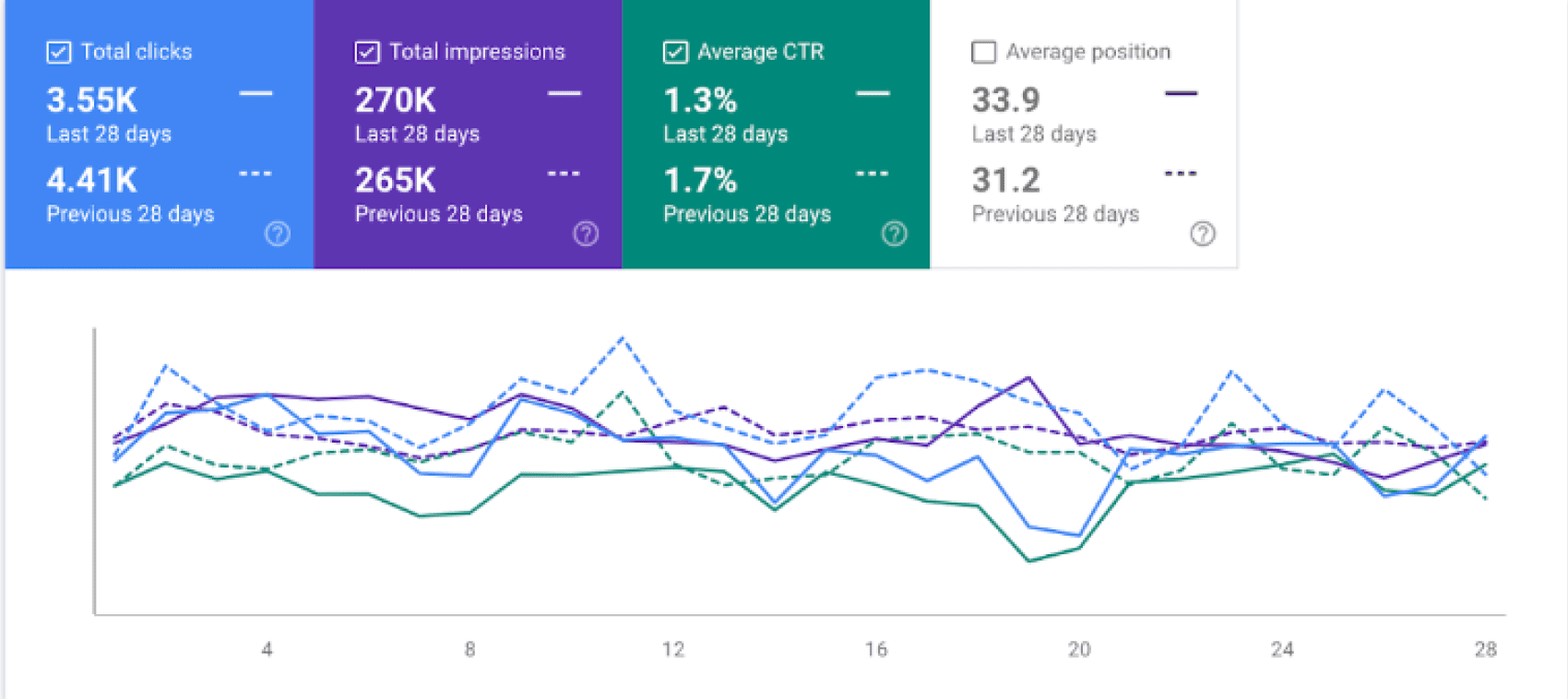
5. Bounce rate
The bounce rate represents the proportion of visitors who leave a website after coming to just one page. A heightened bounce rate may signal the necessity of incorporating or modifying call-to-action (CTA) elements within content marketing posts.
Google employs bounce rate as one of the metrics for determining a website's ranking. A notable bounce rate indicates that visitors are not discovering the desired content on your client’s website. Given that Google's algorithm continuously adjusts to deliver pertinent content to the appropriate audience, a heightened bounce rate can adversely affect SEO rankings.
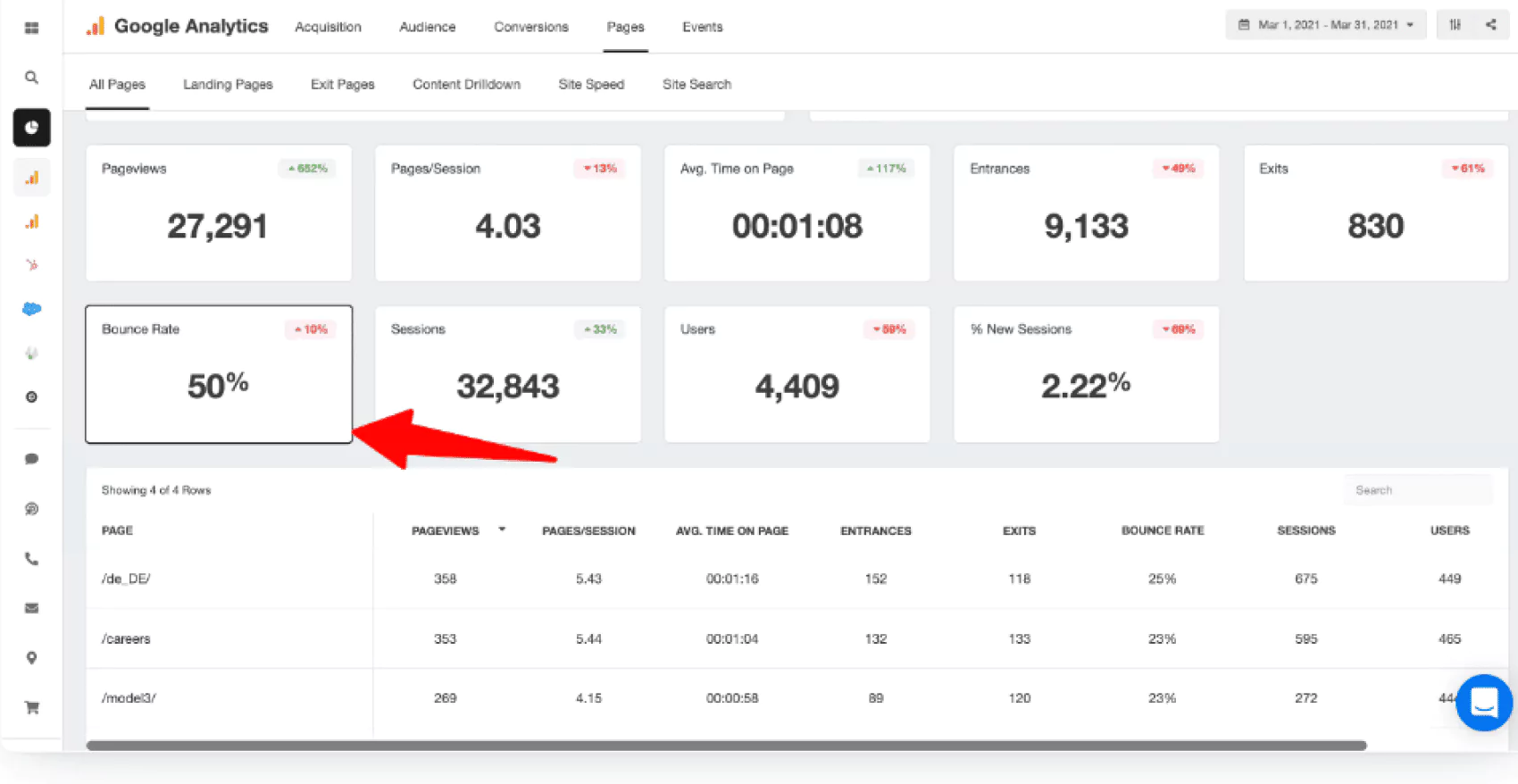
Recognizing that a high bounce rate isn't invariably a cause for concern is important.
Understanding your bounce rate is crucial for making informed decisions across various aspects of digital marketing, including content marketing, paid digital ads, SEO, and user experience optimization. By tracking your bounce rate, you can assess the effectiveness of your strategies and determine whether changes yield positive or negative outcomes.
Still, it's crucial to mention that a high bounce rate doesn't always indicate poor performance. Additionally, simply aiming to lower bounce rates may not always result in beneficial outcomes. For instance, in an A/B test scenario, reducing the bounce rate may coincide with a drop in conversions and revenue. In such cases, prioritizing metrics that directly impact revenue generation is paramount, rather than solely focusing on engagement metrics like bounce rates.
While bounce rates serve as valuable proxy metrics for identifying areas of improvement, they should not be the sole basis for optimization efforts. Instead, they should be viewed as "micro-conversions" – helpful indicators that provide insights into user behavior but should be considered alongside other key performance metrics. Relying solely on bounce rates for conversion optimization can lead to misleading conclusions and ineffective strategies.
Want to create the top content? Our specialists will deliver exceptional content. Contact us
6. Social media engagement rates
Monitoring social media engagements, including likes, shares, comments, video views, and other interactions, offers valuable insights into audience engagement with your content. This tracking can be done on a per-post basis or aggregated over a specified period.
Analyzing engagement metrics longitudinally enables you to discern trends and patterns, identifying the content types that resonate most effectively with your audience. Utilizing each platform's native analytics tools facilitates efficient tracking of social media engagement metrics content marketing specialists need.
Below, you can see an Instagram post and indicators of viewer activity under it, such as likes, comments, sharing, and savings.
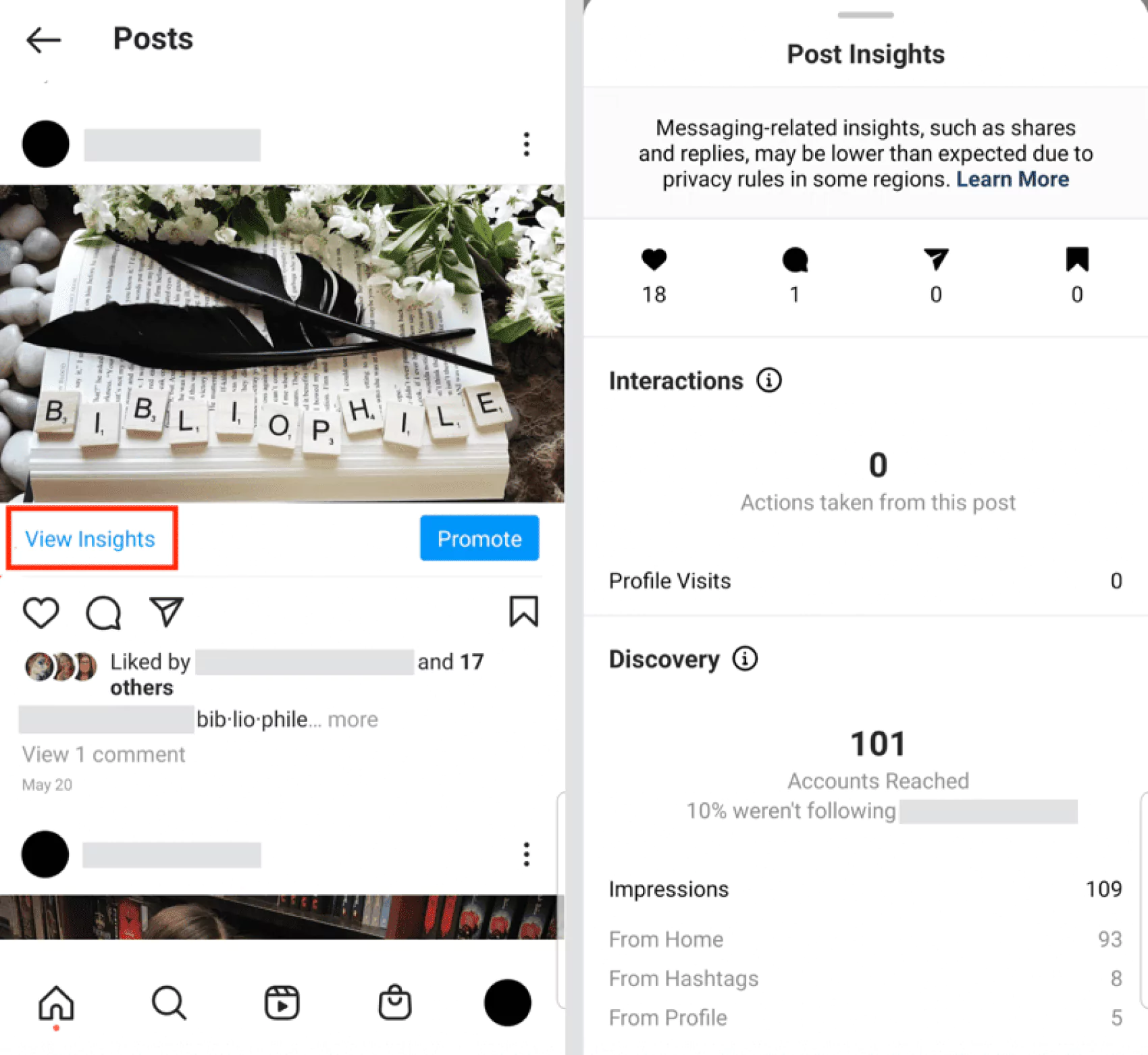
Practical application of metrics in content evaluation
Understanding content metrics is only half the battle. Their application in evaluating and improving content is vital to building marketing strategies. Here are a few steps on how you can apply metrics to improve content quality:
Data analysis and identification of trends: Use the data you collect to identify trends and understand what types of content best engage with your audience.
Assessment of key indicators: When focusing on key metrics (clicks, time on page), compare the data to your goals and previous results to identify progress or the need for change.
Conversion analysis: Link content metrics to conversions. Evaluate which types of content or which topics are more conducive to your end goal, be it a sale, a subscription, or a signup.
Experiments and adjustments: Based on data analysis, you can conduct experiments. For example, change content formats, topics, and publication times and study how this affects the metrics. Correct your marketing strategy based on the results.
Regular content updates: Use metrics to identify irrelevant content and update it. Updated content often attracts more attention and improves audience retention.
Constantly learning and adapting: The content strategy must be constantly updated and adapted based on data analysis. Regularly review your results, adapt your approach, and use new ideas to improve your content.
Metrics are not limited to tracking numbers. They help you take a more conscious and systematic approach to creating and improving material, ultimately contributing to an effective marketing strategy.
Conclusion: content + marketing + consistency = success
Establishing content metrics to gauge performance when devising a content marketing strategy for your agency or clients is crucial. By aligning with desired ROI outcomes, such as leads or purchases, you can determine the necessary traffic and conversion rates. This will help you attain your objectives and raise your visibility for clients on search engines.
Each of these best content marketing metrics serves as a vital measure of campaign success. However, consolidating them into a content marketing dashboard allows for precisely identifying effective strategies and areas needing improvement. Whether adjusting content types to enhance bounce rates or refining distribution strategies, remember that content marketing represents a significant investment. However, all your efforts will pay in the long run and bring your business engaged customers and profit.
Contact usto transform your content into a powerful growth engine for your business! Сheck out our portfolio to see how we helped businesses across various industries flourish.







